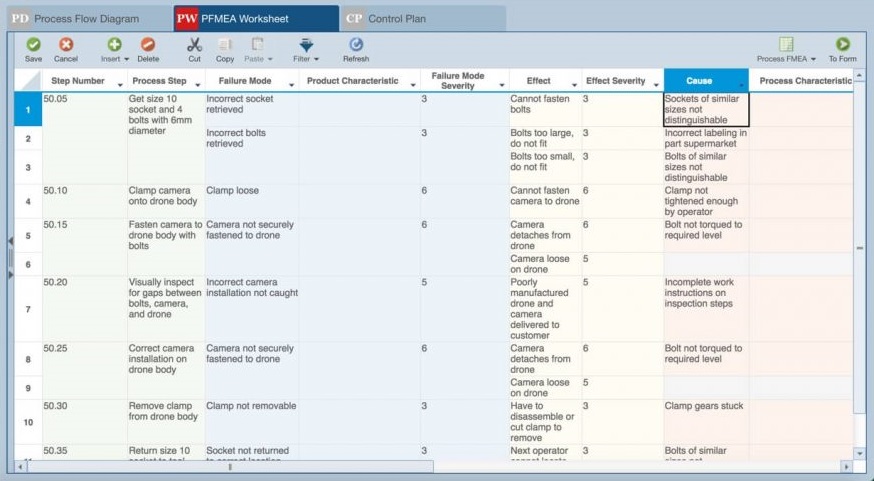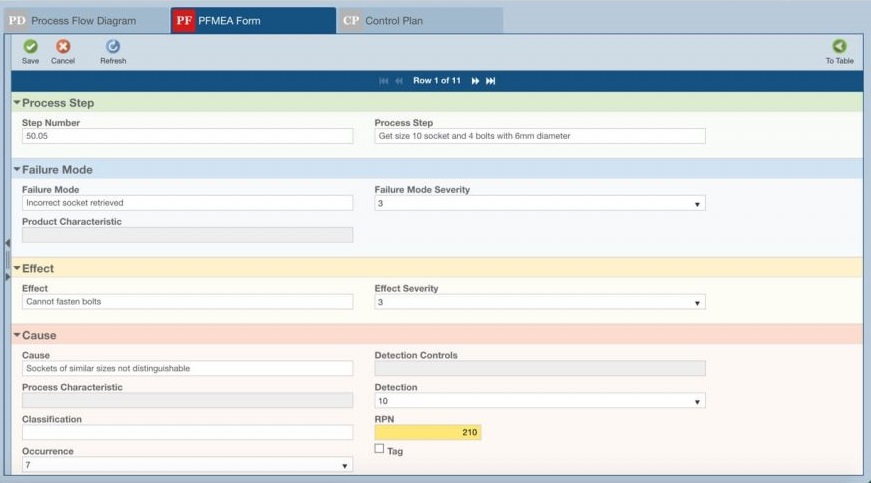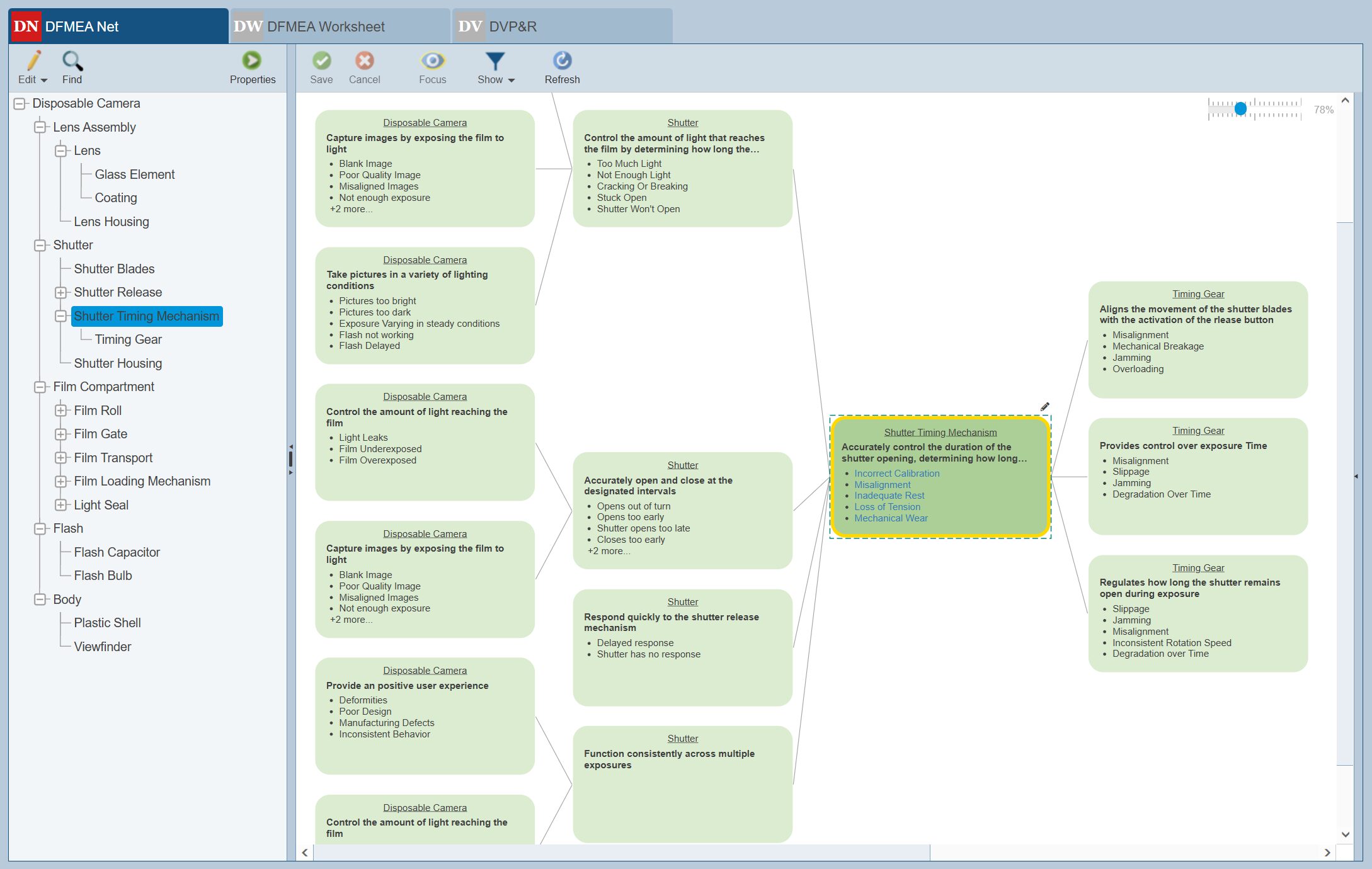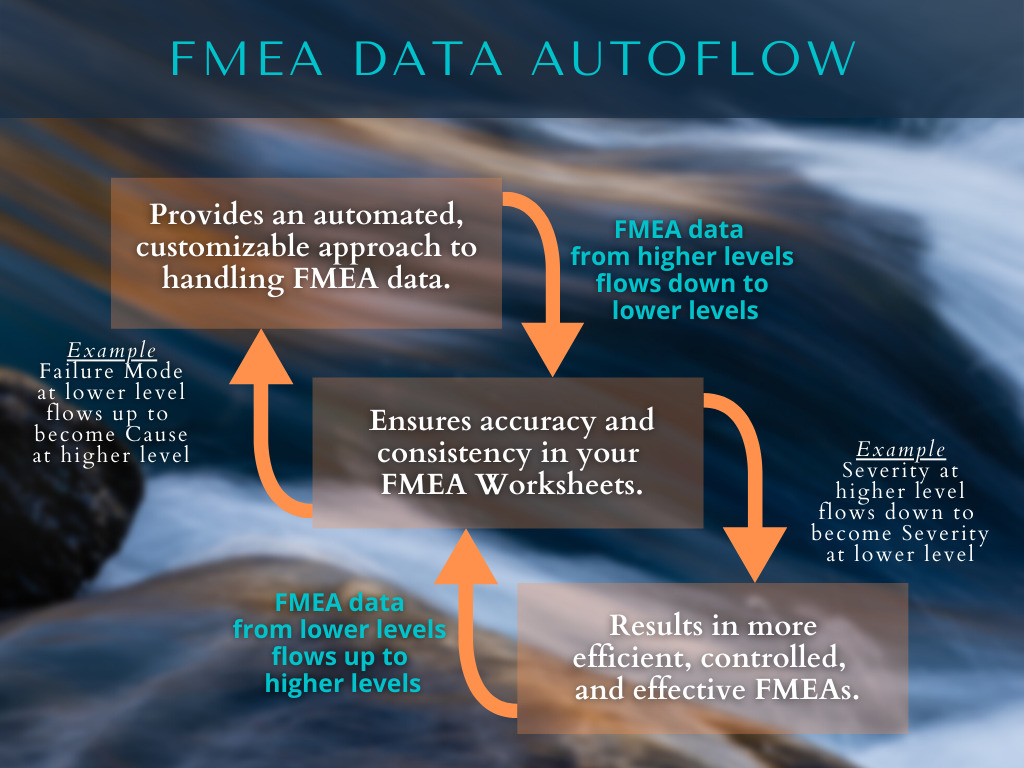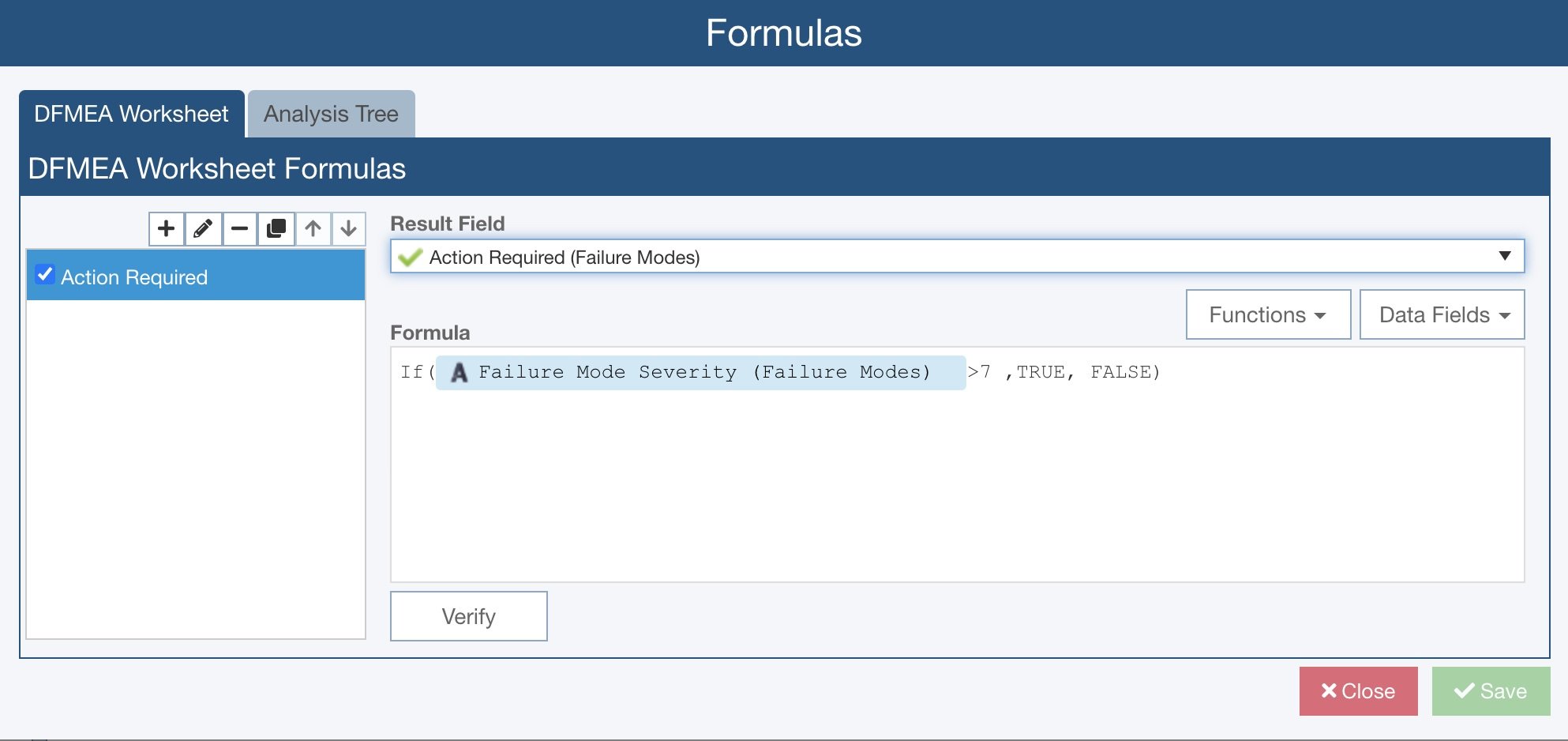THE FMEA TOOL OF CHOICE
FMEAs require the efficient handling of a large amount of data. The organization of this wealth of information along with team collaboration activities are key to effective FMEA management. This is where Relyence FMEA shines. Wrapping an intuitive interface around a feature-rich FMEA package, Relyence FMEA enables you to manage your FMEA process with ease and efficiency. Spreadsheet tools are no match for Relyence FMEA with its intuitive interface, built-in calculations, always-in-syncTM technology, audit trail tracking, custom Formulas, insightful visual tools, and innovations such as the Knowledge BankTM for data reusability, FMEA Data AutoflowTM for automated data handling, FMEA SmartSuggestTM to ensure complete coverage, and Failure Direct ConnectTM for FMEA and FRACAS integration.
Intuitive Worksheet Functionality
Your work center in Relyence FMEA is the Worksheet. The Worksheet is tailored to the FMEA template of choice, with color-coding and data grouping to aid in understanding. Auto-complete functionality is built-in to allow quick and easy reuse of your textual data to ensure consistency, eliminate errors, and reduce the time required to complete your analysis, significantly improving efficiency. Worksheet layout is completely customizable and functionality is intuitive and mobile-friendly.
FMEA Forms
The Relyence FMEA Worksheet view is augmented with the Relyence FMEA Forms interface that offers a form-based view of your FMEA data. The Form View supports the same features and functionality of the Worksheet interface. The Form View can be used as your main interface if you prefer, or you can access it on-demand to get an expanded view of a single FMEA line item. Moving between the two views is a streamlined one-click operation. And, Relyence’s flexible report generation offers the ability to create custom FMEA Form reports using the Report Templates feature.
Risk Metrics
Relyence FMEA supports the automatic assessment of risk metrics of your identified failures. Available metrics include Risk Priority Numbers (RPN) used in AIAG and SAE J1739 compliant FMEAs, the criticality values defined in MIL-STD-1629 FMECAs, and Action Priorities (AP) as described in the AIAG & VDA FMEA standard.
RPN and AP values are color-coded based on risk level, and can be customized to meet your needs. Relyence FMEA RPN, AP, and criticality values can be included in your Relyence FMEA Dashboards allowing you to monitor these vital statistics at a high level.
Knowledge BankTM
The FMEA Knowledge Bank provides a powerful way to organize and automate your FMEAs. Knowledge Banks allow you to create a database of shared FMEA information, ensuring that lessons learned are retained and carried through to new projects. This database of FMEA information can also be known as a shell, template, or foundation FMEA.
Add any FMEA information from your FMEA to your Knowledge Bank – FMEA Functions, Failure Modes, Effects, Actions, Process Steps, and even full components or systems. As you perform your FMEAs, use the flexible search feature to mine your Knowledge Bank for information pertinent to your analyses. Another single click, and that prior knowledge is retrieved into your current analysis. Never lose any of your critical lessons learned!
Plus, the Relyence FMEA Knowledge Bank keeps your FMEAs in sync automatically, if you desire. Modifications made to your Knowledge Bank data can ripple through all your FMEAs that have data ties to the Knowledge Bank.
Visual Tools for System Insight
Relyence FMEA includes built-in visual tools to assist in system understanding and aid in FMEA Worksheet completion.
Function and Failure Nets provide a visual tool for analyzing system vulnerabilities and enhancing risk mitigation. Function Nets map Function relationships to reveal design weaknesses, while Failure Nets illustrate how failures propagate, helping identify critical failure paths.
Boundary Diagrams visually represent a system’s components and their interactions with internal and external elements, helping define the scope of analysis in the FMEA process. Often used as the first step in the DFMEA process, they serve as a useful brainstorming tool to ensure all relevant factors are considered.
P-Diagrams offer a visual overview of system inputs, outputs, control factors, error states, and noise factors, aiding in the early stages of the FMEA process. They help assess whether design outputs meet requirements and can be helpful in understanding the overall system and the interactions of various factors influencing successful operation.
FMEA Data AutoflowTM
Relyence FMEA Data Autoflow enables you to establish and manage relationships between your FMEA data using an automated approach.
For example, consider a FMECA Worksheet where there are typically three levels of Effects: Local Effect, Next Effect, and End Effect. For each line item in your FMECA Worksheet you enter the effect of the failure on the specific item (Local Effect), the effect of the failure on the next level (Next Effect), and finally, the resulting effect at the top-level of the system (End Effect).
When performing the FMECA, it would be beneficial if the Next Effects and End Effects could be entered in the Worksheet in an automated fashion. For example, if the Local Effect is entered at the very top level, this would propagate down my FMECA hierarchy as Next and End Effects at the appropriate lower levels. Based on my FMECA hierarchy, my FMEA software should be able to determine this data relationship and fill in the Worksheet accordingly. This is just one example of what FMEA Data Autoflow has been designed to do.
There are a variety of ways analysts may want to have FMEA data flow up and down Worksheets in an automated way. The connections between FMEA data are dependent not only on what type of FMEA you employ, but also your specific case and organization. For this reason, Relyence FMEA Data Autoflow is completely customizable. In addition, Relyence FMEA Data Autoflow includes a number of predefined Autoflow rules you can select from. These built-in rules are the most commonly used data flows. You can also start with any of the predefined rules and modify them to suit your needs.
This innovative Relyence-only feature means your FMEA process is more controlled and consistent than possible using simple Excel-based FMEA templates.
FMEA SmartSuggestTM
The innovative and useful FMEA SmartSuggest offers a unique approach for keeping your FMEA data synchronized throughout your Analysis Tree hierarchy.
FMEA SmartSuggest aids you in making sure your FMEA coverage is complete and you have not overlooked failure modes and/or effects that should be taken into consideration. Especially useful for instances where FMEAs are performed across various system components and across multiple Worksheets, SmartSuggest analyzes your FMEA Worksheets and provides a list of suggestions to consider for inclusion in your current FMEA. From the SmartSuggest panel, you can see recommended data suggestions and then choose those that are most appropriate for your analysis.
FMEA SmartSuggest also incorporates a Highlight Warnings feature that highlights specific data entries in your FMEA Worksheet that may be out of sync based on related FMEA data from higher or lower level FMEAs.
Failure Direct ConnectTM
The unique-to-Relyence Failure Direct Connect capability offers an innovative and new approach to integrating your FRACAS and FMEA processes.
With Failure Direct Connect, your FRACAS team is able to connect directly to your FMEA failure data. If FRACAS team members uncover a new failure mode, they can make a request that the FMEA team review and decide how to proceed with the newly discovered item.
With this notable feature you have ability to directly connect your FMEA and FRACAS processes and effectively manage your failure information across the product lifecycle.
Formulas
Relyence FMEA includes an intuitive interface to define your own completely customized Formulas. You can create Formulas to operate on your FMEA Worksheet data, as well as Formulas that operate on Analysis Tree data. This powerful feature allows you to create your own equations for keeping track of your own FMEA metrics.
A wide range of flexibility is available for creating basic as well as complex Formulas, such as those including logical operators (AND, OR, <>, etc.), constants, dates, and programmatic functions (if/then/else).
FMEA Formulas also support Roll-up and Aggregate functions such as SUM and AVG to provide cumulative calculations.
Audit Trails
Relyence FMEA supports Audit Trails to track and record all data changes made to your analyses. Often used for security and tracking purposes, audit trails provide a detailed log of data modifications. Audit trails are also helpful to answer critical questions such as “Who made this change?”, or “When was this change made?”.
You can review automatically logged FMEA audit trail data in several ways:
- By individual data field. For example, view all changes made to the “Recommended Action” field.
- By line item. For example, view all changes made to a single Failure Mode.
- Entire FMEA. Generate a full audit trail report for your entire FMEA to an Excel or CSV format.

Excel-based FMEAs are no match for Relyence!
While oftentimes small FMEAs are performed using Excel, the limitations quickly become apparent with this approach. Including the benefits detailed above, the following is a list of the many advantages of relying on the Relyence best-in-class FMEA software tool over Excel for your analyses:
- Text phrases are organized and managed for you. Built-in auto-complete ensures consistency and accuracy of wording of your failure modes, effects, causes, and all your FMEA information.
- The unique FMEA Knowledge BankTM provides a powerful way to organize and automate your FMEAs, and ensures you capture and retain lessons learned.
- The powerful FMEA Data AutoflowTM handles your FMEA data relationships up and down your FMEA hierarchy using an automated, customizable approach.
- The helpful FMEA SmartSuggestTM that ensures that your FMEA coverage is complete and that data is synchronized across all levels of your Analysis Tree.
- The innovative Failure Direct ConnectTM offers a streamlined way to integrate your FMEA and FRACAS failure information.
- PFMEAs, Process Flow Diagrams, and Control Plans employ Relyence FMEA’s unique always-in-sync™ technology so your PFMEA process are continually managed and remain in an audit-ready state. The always-in-sync feature plays a key role in avoiding NCRs (Non-Conformance Reports).
- DFMEAs and PFMEAs can be managed in a controlled fashion using Product Characteristics for integration across your FMEA types.
- Custom Boundary Diagrams and P-Diagrams provide high-level visual overviews of your system’s components, their interactions with other elements, and all appropriate inputs, outputs, and other associated factors.
- Function and Failure Nets offer visual system analysis, allowing you to reveal design weaknesses and illustrate failure propagation to identify critical failure paths.
- Piece-part DFMEAs and FMECAs can access the built-in FMD-2016 Failure Mode Distribution database or you can create your own custom Part Failure Modes Library for efficiency and automation.
- Calculations are automatic.
- Criticality calculations including RPN and AP are built-in and can be customized.
- Classification Symbols to highlight critical or key items are built-in and fully customizable for use across your DFMEAs, PFMEAs, and FMEA-MSRs.
- Relyence FMEA is available in the cloud over the Internet for quick and easy collaboration.
- Relyence FMEA operates on your PC, your Mac, your tablet, and even your smartphone.
- You can easily import your analyses from Excel or other applications.
- Support for hierarchical FMEAs allows grouping your analyses for a powerful organizational method.
- You can easily create FMEAs for multiple iterations of your product or system, all in one place.
- You can create FMEAs based on other FMEAs including both layout options and previous FMEA data.
- You can create multiple views of your data and switch between them in a single click.
- Trackable audit control including comprehensive reports for compliance requirements is available through FMEA Audit Trails.
- FMEA Dashboards allow you to see key metrics on your data such as:
- Top failure modes
- Overdue actions
- Risk and criticality matrices

